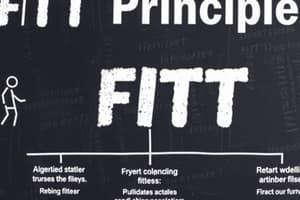Podcast
Questions and Answers
Which exercise is categorized as an advanced cardio workout?
Which exercise is categorized as an advanced cardio workout?
- Swimming laps
- Light cycling
- Sprint intervals (correct)
- Low-impact aerobics
What type of exercise is a regular push-up categorized under?
What type of exercise is a regular push-up categorized under?
- Cardio
- Core Strength
- Flexibility
- Strength (Upper) (correct)
Which of the following is a beginner-level core strength exercise?
Which of the following is a beginner-level core strength exercise?
- Russian twists (with weight)
- Side planks
- Hanging leg raises
- Basic planks (15--30 sec) (correct)
Which exercise belongs to the category of advanced flexibility training?
Which exercise belongs to the category of advanced flexibility training?
Identify the exercise classified as an intermediate strength (lower) workout.
Identify the exercise classified as an intermediate strength (lower) workout.
What does the 'I' in the FITT Principle represent?
What does the 'I' in the FITT Principle represent?
Which of the following is a correct statement regarding the application of the FITT Principle for flexibility training?
Which of the following is a correct statement regarding the application of the FITT Principle for flexibility training?
Which principle of training emphasizes the need to tailor fitness programs to the individual's needs?
Which principle of training emphasizes the need to tailor fitness programs to the individual's needs?
What is the recommended intensity level for strength training as per the FITT Principle?
What is the recommended intensity level for strength training as per the FITT Principle?
What is a key benefit of using the FITT Principle for individuals setting fitness goals?
What is a key benefit of using the FITT Principle for individuals setting fitness goals?
How often should cardiovascular training be performed according to the FITT Principle?
How often should cardiovascular training be performed according to the FITT Principle?
Which of the following principles addresses the concept of gradual increases in training stress?
Which of the following principles addresses the concept of gradual increases in training stress?
Which component of the FITT Principle focuses on the kind of exercise performed?
Which component of the FITT Principle focuses on the kind of exercise performed?
Flashcards
Beginner Cardio
Beginner Cardio
Gentle exercises that get your heart rate up and improve cardiovascular health. Examples include brisk walking, light cycling, and low-impact aerobics.
Intermediate Cardio
Intermediate Cardio
More challenging exercises that build upon beginner cardio, with higher intensity and longer durations. Examples include running, swimming laps, and stair climbing.
Advanced Cardio
Advanced Cardio
Intense and challenging exercises that require high levels of fitness. Examples include sprint intervals, HIIT, and rowing sprints.
Beginner Strength (Upper)
Beginner Strength (Upper)
Signup and view all the flashcards
Beginner Strength (Lower)
Beginner Strength (Lower)
Signup and view all the flashcards
FITT Principle
FITT Principle
Signup and view all the flashcards
Frequency (FITT)
Frequency (FITT)
Signup and view all the flashcards
Intensity (FITT)
Intensity (FITT)
Signup and view all the flashcards
Time (FITT)
Time (FITT)
Signup and view all the flashcards
Type (FITT)
Type (FITT)
Signup and view all the flashcards
Specificity (Training Principle)
Specificity (Training Principle)
Signup and view all the flashcards
Progressive Overload (Training Principle)
Progressive Overload (Training Principle)
Signup and view all the flashcards
Reversibility (Training Principle)
Reversibility (Training Principle)
Signup and view all the flashcards
Study Notes
FITT Principle
- The FITT Principle guides effective exercise programs
- It stands for Frequency, Intensity, Time, and Type
- These components structure fitness regimens
Frequency
- Definition: How often you exercise
- Guidelines:
- Cardio: At least 3-5 days per week
- Strength training: 2-3 days per week, with rest
- Flexibility: 2-3 days per week or more
Intensity
- Definition: How hard you exercise
- Measurement Tools:
- Cardio: Heart rate zones
- Rate of Perceived Exertion (RPE)
- Amount of weight lifted or resistance level
- Examples:
- Light intensity: Comfortable walking
- Moderate intensity: Jogging or cycling
- High intensity: Sprinting or heavy lifting
Time
- Definition: How long you exercise per session
- Guidelines:
- Cardio: 20-60 minutes per session
- Strength training: 30-60 minutes, focusing on sets and repetitions
- Flexibility: 10-30 minutes
Type
- Definition: The kind of exercise
- Examples:
- Cardio: Running, cycling, swimming
- Strength: Weightlifting, resistance bands, bodyweight exercises
- Flexibility: Yoga, static stretching, functional training
Applying the FITT Principle
- Set fitness goals (e.g., weight loss, muscle building, endurance)
- Adjust components based on goals, fitness level, and progress
- Gradually increase intensity, frequency, or time to avoid plateaus
- Prevent overtraining
Benefits of the FITT Principle
- Structures and balances workouts
- Promotes progression and avoids stagnation
- Reduces risk of overtraining and injuries
- Keeps workouts engaging
Sample FITT Principle Table (Customization Possible)
| Component | Cardio Training | Strength Training | Flexibility Training |
|---|---|---|---|
| Frequency | 3-5 days/week | 2-3 days/week | 2-3 days/week (or daily) |
| Intensity | Moderate to vigorous (60-85% max heart rate) | Moderate to high (70-90% 1RM) | Stretch to point of mild tension |
| Time | 20-60 minutes/session | 30-60 minutes/session | 10-30 seconds/stretch, 2-4 reps |
| Type | Running, cycling, swimming | Weightlifting, bodyweight exercises | Yoga, static stretching, dynamic stretching |
Principles of Training
- Specificity: Training relevant to goals and sport demands (e.g., sprinters, swimmers)
- Progressive Overload: Gradually increase intensity, volume, or complexity for improvement (e.g., increase weights, reduce rest)
- Reversibility: Fitness loss with reduced or stopped training
- Individuality: Tailor training to individual abilities, goals, fitness levels
- Variation: Vary exercises, styles, and intensities to improve engagement
- Adaptation: Body adapts to training demands
- Recovery: Rest and recovery essential for muscle repair, strength gains
Sample Exercises (Categorized)
- (The table shows exercises organized by training type, categorized further as beginner, intermediate and advanced)*
Studying That Suits You
Use AI to generate personalized quizzes and flashcards to suit your learning preferences.




